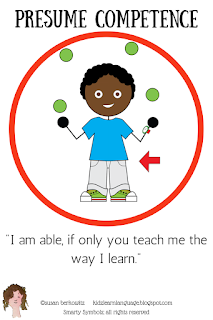“There is nothing in a caterpillar that tells you it’s going to be a butterfly.” ‐ Buckminster Fuller
This quote from Buckminster Fuller appears at the beginning of Hussman’s (2017) Autism Support manual entitled, “Presume Competence; Autism support 1.0.”
I’ve been hearing some backlash against presuming competence in our AAC users/ potential users recently. The greatest number of students with autism I have worked with over the past 44 years have been nonverbal or minimally verbal. And at some point in every one of these children’s academic career has been the question, “Are we expecting too much? Or too little?”
Over the course of Special Education as it has existed both before PL94-142 and after, we have a miserable history of under-estimating the potential of many of these students and offering them far too little education and support.
Yet, with recently higher expectations we’ve seen these students succeed at tasks “we” thought they could not. We’ve discovered literacy skills in students who have, historically, not even been taught to read. We’ve discovered communication skills in students we thought would never learn beyond, perhaps, some basic requesting.
I recently read a discussion about how those who eschew the “presume competence” construct are not actually presuming incompetence, but rather are avoiding putting too many eggs in a particular child’s basket.
To me, this discussion smacks of cognitive referencing; a practice that ASHA has firmly denounced. Unfortunately, the term is being used a lot by practitioners of Facilitated Communication, a practice that ASHA has also denounced.
Hussman’s manual lists the following constructs:
- Presume competence
- Follow the lead
- Make communication the centerpiece
- Offer positive behavior support
- Include and adapt
- Accommodate sensory and movement differences
- Build relationships
- Support autonomy
It strikes me that these are the very ideas that we need when working with students who need to use AAC to be verbal. They are, in fact, exactly what I, and others in the AAC arena have posited for many years.
Hussman goes on to say:
“What you will need is the awareness and patience to embrace people with autism as different, not less; the willingness to presume that people with autism are competent – even if evidence may be not be available at first; and the understanding that behavior is not random, but is instead motivated by necessity, frustration, sensory differences, or the need to communicate a request or thought. “
Hussman further says that what is needed is the kind of engagement and interaction that provide the student with models of language models that the students can then process, copy, and eventually use.
This sounds to me like the very process that our AAC users need; this aided input or modeling of the AAC system. And I very much worry about what will happen if we stop presuming competence in our students with the most complex communication needs.
I’d like to end this post with the stories of 2 young men and their AAC.
One, is shown in this short video created by MeloSpeech about one of my students. You can see it here: https://www.youtube.com/watch?v=CAVt79wbFc0
The other is another amazing young man who could have continued to be locked in if his parents had not presumed his competence. He has severe cerebral palsy; spastic quadriplegia. His time in school was consistently characterized by sitting in his wheelchair in the back of the classroom, doing nothing. Because they could not see a way to engage him or get a response from him, they ignored him.
His parents took him out of school at 16, and placed him in an adult day program, which happened to bee run buy an organization that understood communication strategies. They made a picture communication book, and taught him to use Partner Assisted Scanning strategies.
Once an Assistive Technology Center opened in his area, his parents brought him to the center for an AAC assessment. To get to the punchline, when the dynamic display speech generating device arrived and was mounted on his wheelchair, the first thing he did was to use the switch to navigate to the keyboard, which he used to say, “Thank you so much. Now I can talk like everyone else.” Nobody ever taught this young man to read. They assumed he could not. He sat in the back of those classrooms and learned incidentally. Where would he be if nobody presumed he was competent?
The bottom line:
“All individuals, regardless of the severity of their disability, have the basic right to ongoing instruction that will help them develop versatile communication skills.” (Geist, Erickson, et al, 2016)




This comment has been removed by a blog administrator.
ReplyDelete